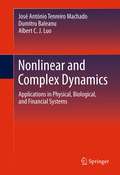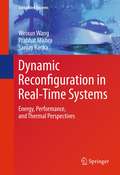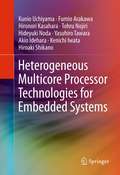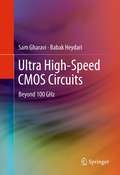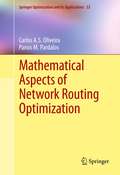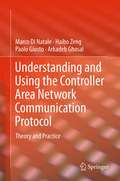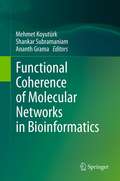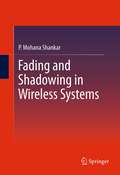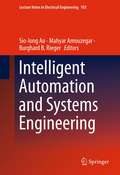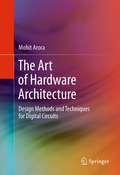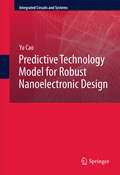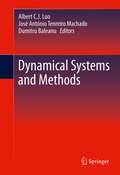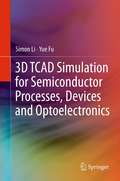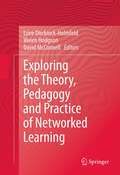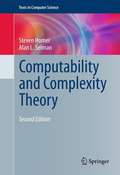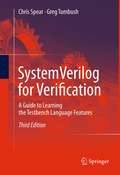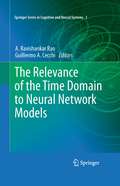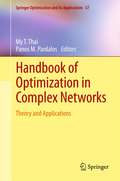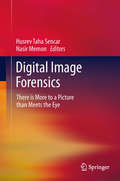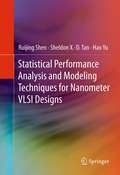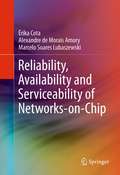- Table View
- List View
Nonlinear and Complex Dynamics
by Albert C. Luo José António Machado Dumitru BaleanuNonlinear Dynamics of Complex Systems describes chaos, fractal and stochasticities within celestial mechanics, financial systems and biochemical systems. Part I discusses methods and applications in celestial systems and new results in such areas as low energy impact dynamics, low-thrust planar trajectories to the moon and earth-to-halo transfers in the sun, earth and moon. Part II presents the dynamics of complex systems including bio-systems, neural systems, chemical systems and hydro-dynamical systems. Finally, Part III covers economic and financial systems including market uncertainty, inflation, economic activity and foreign competition and the role of nonlinear dynamics in each.
Forensic Speaker Recognition
by Amy Neustein Hemant A. PatilForensic Speaker Recognition: Law Enforcement and Counter-Terrorism is an anthology of the research findings of 35 speaker recognition experts from around the world. The volume provides a multidimensional view of the complex science involved in determining whether a suspect's voice truly matches forensic speech samples, collected by law enforcement and counter-terrorism agencies, that are associated with the commission of a terrorist act or other crimes. While addressing such topics as the challenges of forensic case work, handling speech signal degradation, analyzing features of speaker recognition to optimize voice verification system performance, and designing voice applications that meet the practical needs of law enforcement and counter-terrorism agencies, this material all sounds a common theme: how the rigors of forensic utility are demanding new levels of excellence in all aspects of speaker recognition. The contributors are among the most eminent scientists in speech engineering and signal processing; and their work represents such diverse countries as Switzerland, Sweden, Italy, France, Japan, India and the United States. Forensic Speaker Recognition is a useful book for forensic speech scientists, speech signal processing experts, speech system developers, criminal prosecutors and counter-terrorism intelligence officers and agents.
Dynamic Reconfiguration in Real-Time Systems
by Sanjay Ranka Prabhat Mishra Weixun WangGiven the widespread use of real-time multitasking systems, there are tremendous optimization opportunities if reconfigurable computing can be effectively incorporated while maintaining performance and other design constraints of typical applications. The focus of this book is to describe the dynamic reconfiguration techniques that can be safely used in real-time systems. This book provides comprehensive approaches by considering synergistic effects of computation, communication as well as storage together to significantly improve overall performance, power, energy and temperature.
Heterogeneous Multicore Processor Technologies for Embedded Systems
by Tohru Nojiri Kenichi Iwata Fumio Arakawa Yasuhiro Tawara Kunio Uchiyama Hironori Kasahara Hiroaki Shikano Hideyuki Noda Akio IdeharaTo satisfy the higher requirements of digitally converged embedded systems, this book describes heterogeneous multicore technology that uses various kinds of low-power embedded processor cores on a single chip. With this technology, heterogeneous parallelism can be implemented on an SoC, and greater flexibility and superior performance per watt can then be achieved. This book defines the heterogeneous multicore architecture and explains in detail several embedded processor cores including CPU cores and special-purpose processor cores that achieve highly arithmetic-level parallelism. The authors developed three multicore chips (called RP-1, RP-2, and RP-X) according to the defined architecture with the introduced processor cores. The chip implementations, software environments, and applications running on the chips are also explained in the book. Provides readers an overview and practical discussion of heterogeneous multicore technologies from both a hardware and software point of view;Discusses a new, high-performance and energy efficient approach to designing SoCs for digitally converged, embedded systems;Covers hardware issues such as architecture and chip implementation, as well as software issues such as compilers, operating systems, and application programs;Describes three chips developed according to the defined heterogeneous multicore architecture, including chip implementations, software environments, and working applications.
Ultra High-Speed CMOS Circuits
by Sam Gharavi Babak HeydariThe book covers the CMOS-based millimeter wave circuits and devices and presents methods and design techniques to use CMOS technology for circuits operating beyond 100 GHz. Coverage includes a detailed description of both active and passive devices, including modeling techniques and performance optimization. Various mm-wave circuit blocks are discussed, emphasizing their design distinctions from low-frequency design methodologies. This book also covers a device-oriented circuit design technique that is essential for ultra high speed circuits and gives some examples of device/circuit co-design that can be used for mm-wave technology.
Mathematical Aspects of Network Routing Optimization
by Panos M. Pardalos Carlos A.S. OliveiraBefore the appearance of broadband links and wireless systems, networks have been used to connect people in new ways. Now, the modern world is connected through large-scale, computational networked systems such as the Internet. Because of the ever-advancing technology of networking, efficient algorithms have become increasingly necessary to solve some of the problems developing in this area. "Mathematical Aspects of Network Routing Optimization" focuses on computational issues arising from the process of optimizing network routes, such as quality of the resulting links and their reliability. Algorithms are a cornerstone for the understanding of the protocols underlying multicast routing. The main objective in the text is to derive efficient algorithms, with or without guarantee of approximation. Notes have been provided for basic topics such as graph theory and linear programming to assist those who are not fully acquainted with the mathematical topics presented throughout the book. "Mathematical Aspects of Network Routing Optimization" provides a thorough introduction to the subject of algorithms for network routing, and focuses especially on multicast and wireless ad hoc systems. This book is designed for graduate students, researchers, and professionals interested in understanding the algorithmic and mathematical ideas behind routing in computer networks. It is suitable for advanced undergraduate students, graduate students, and researchers in the area of network algorithms.
Understanding and Using the Controller Area Network Communication Protocol
by Paolo Giusto Arkadeb Ghosal Haibo Zeng Marco Di NataleThis book to offers a hands-on guide to designing, analyzing and debugging a communication infrastructure based on the Controller Area Network (CAN) bus. Although the CAN bus standard is well established and currently used in most automotive systems, as well as avionics, medical systems and other devices, its features are not fully understood by most developers, who tend to misuse the network. This results in lost opportunities for better efficiency and performance. These authors offer a comprehensive range of architectural solutions and domains of analysis. It also provides formal models and analytical results, with thorough discussion of their applicability, so that it serves as an invaluable reference for researchers and students, as well as practicing engineers.
Functional Coherence of Molecular Networks in Bioinformatics
by Ananth Grama Mehmet Koyutürk Shankar SubramaniamMolecular networks provide descriptions of the organization of various biological processes, including cellular signaling, metabolism, and genetic regulation. Knowledge on molecular networks is commonly used for systems level analysis of biological function; research and method development in this area has grown tremendously in the past few years. This book will provide a detailed review of existing knowledge on the functional characterization of biological networks. In 15 chapters authored by an international group of prolific systems biology and bioinformatics researchers, it will organize, conceptualize, and summarize the existing core of research results and computational methods on understanding biological function from a network perspective.
Fading and Shadowing in Wireless Systems
by P. Mohana ShankarThe study of signal transmission and deterioration in signal characteristics as the signal propagates through wireless channels is of great significance. The book presents a comprehensive view of channel degradation arising from fading and shadowing. Various statistical models including simple, hybrid, compound, complex and cascaded ones are presented with detailed derivations along with measures to quantify the deterioration such as the amount of fading, error rates and outage probabilities. The models range from the Rayleigh and Rician through Suzuki, generalized K, cascaded and alpha-mu and similar ones. This is followed by the analysis of mitigation of fading and shadowing through diversity (simple, hybrid, micro- and macro- level) and combining algorithms. The density and distribution functions, error rates and outages are derived and results analyzed to quantify the improvements. The effects of co-channel interference before and after the implementation of diversity are also analyzed. To facilitate easy understanding of the models and analysis, the background information in terms of probability and random variables is presented with relevant derivations of densities of linear and nonlinear transformation of random variables, the sums, products, ratios as well as order statistics of random variables of all types. The book also provides material on digital modems of interest in wireless systems. Thus, the book with 1100+ equations and 350+ Matlab generated figures and tables is an ideal source for students, educators, researchers and professionals in wireless communications allowing access to information currently unavailable.
Intelligent Automation and Systems Engineering
by Sio-Iong Ao Burghard B. Rieger Mahyar AmouzegarIntelligent systems are required to facilitate the use of information provided by the internet and other computer based technologies. This book describes the state-of-the-art in Intelligent Automation and Systems Engineering. Topics covered include Intelligent decision making, Automation, Robotics, Expert systems, Fuzzy systems, Knowledge-based systems, Knowledge extraction, Large database management, Data analysis tools, Computational biology, Optimization algorithms, Experimental designs, Complex system identification, Computational modeling, Systems simulation, Decision modeling, and industrial applications.
The Art of Hardware Architecture
by Mohit AroraThis book highlights the complex issues, tasks and skills that must be mastered by an IP designer, in order to design an optimized and robust digital circuit to solve a problem. The techniques and methodologies described can serve as a bridge between specifications that are known to the designer and RTL code that is final outcome, reducing significantly the time it takes to convert initial ideas and concepts into right-first-time silicon. Coverage focuses on real problems rather than theoretical concepts, with an emphasis on design techniques across various aspects of chip-design.
Lee de Forest
by Mike AdamsThe life-long inventor, Lee de Forest invented the three-element vacuum tube used between 1906 and 1916 as a detector, amplifier, and oscillator of radio waves. Beginning in 1918 he began to develop a light valve, a device for writing and reading sound using light patterns. While he received many patents for his process, he was initially ignored by the film industry. In order to promote and demonstrate his process he made several hundred sound short films, he rented space for their showing; he sold the tickets and did the publicity to gain audiences for his invention. Lee de Forest officially brought sound to film in 1919. Lee De Forest: King of Radio, Television, and Film is about both invention and early film making; de Forest as the scientist and producer, director, and writer of the content. This book tells the story of de Forest's contribution in changing the history of film through the incorporation of sound. The text includes primary source historical material, U.S. patents and richly-illustrated photos of Lee de Forest's experiments. Readers will greatly benefit from an understanding of the transition from silent to audio motion pictures, the impact this had on the scientific community and the popular culture, as well as the economics of the entertainment industry.
Predictive Technology Model for Robust Nanoelectronic Design
by Yu CaoPredictive Technology Model for Robust Nanoelectronic Design explains many of the technical mysteries behind the Predictive Technology Model (PTM) that has been adopted worldwide in explorative design research. Through physical derivation and technology extrapolation, PTM is the de-factor device model used in electronic design. This work explains the systematic model development and provides a guide to robust design practice in the presence of variability and reliability issues. Having interacted with multiple leading semiconductor companies and university research teams, the author brings a state-of-the-art perspective on technology scaling to this work and shares insights gained in the practices of device modeling.
Dynamical Systems and Methods
by Albert C. Luo José António Machado Dumitru BaleanuNonlinear Systems and Methods For Mechanical, Electrical and Biosystems presents topics observed at the 3rd Conference on Nonlinear Science and Complexity(NSC), focusing on energy transfer and synchronization in hybrid nonlinear systems. The studies focus on fundamental theories and principles,analytical and symbolic approaches, computational techniques in nonlinear physical science and mathematics. Broken into three parts, the text covers: Parametrical excited pendulum, nonlinear dynamics in hybrid systems, dynamical system synchronization and (N+1) body dynamics as well as new views different from the existing results in nonlinear dynamics, mathematical methods for dynamical systems including conservation laws, dynamical symmetry in nonlinear differential equations and invex energies and nonlinear phenomena in physical problems such as solutions, complex flows, chemical kinetics, Toda lattices and parallel manipulator. This book is useful to scholars, researchers and advanced technical members of industrial laboratory facilities developing new tools and products.
Fractional Dynamics and Control
by Albert C. Luo José António Machado Dumitru BaleanuFractional Dynamics and Control provides a comprehensive overview of recent advances in the areas of nonlinear dynamics, vibration and control with analytical, numerical, and experimental results. This book provides an overview of recent discoveries in fractional control, delves into fractional variational principles and differential equations, and applies advanced techniques in fractional calculus to solving complicated mathematical and physical problems.Finally, this book also discusses the role that fractional order modeling can play in complex systems for engineering and science.
3D TCAD Simulation for Semiconductor Processes, Devices and Optoelectronics
by Suihua Li Simon LiTechnology computer-aided design, or TCAD, is critical to today's semiconductor technology and anybody working in this industry needs to know something about TCAD. This book is about how to use computer software to manufacture and test virtually semiconductor devices in 3D. It brings to life the topic of semiconductor device physics, with a hands-on, tutorial approach that de-emphasizes abstract physics and equations and emphasizes real practice and extensive illustrations. Coverage includes a comprehensive library of devices, representing the state of the art technology, such as SuperJunction LDMOS, GaN LED devices, etc.
Exploring the Theory, Pedagogy and Practice of Networked Learning
by David Mcconnell Lone Dirckinck-Holmfeld Vivien HodgsonThis book will be based on a selection of high quality research papers presented at the Networked Learning Conference, May3-4, 2010. The Networked Learning Conference is an international, research-based conference. Since its inception in 1998 the conference has developed a strong following by international researchers. In addition it is well supported by practitioners, managers and learning technologists interested in contributing to and hearing about research in this area. The conference is considered a major event in the international 'technology enhanced learning' conference circuit. This edited volume presents cutting edge research that will explore current trends and advances in research on networked learning, technology enhanced learning and e-learning.
Remote Instrumentation for eScience and Related Aspects
by Roberto Pugliese Norbert Meyer Franco Davoli Sandro Zappatore Jan Węglarz Marcin LawendaThis book will focus on new Remote Instrumentation aspects related to middleware architecture, high-speed networking, wireless Grid for acquisition devices and sensor networks, QoS provisioning for real-time control, measurement instrumentation and methodology. Moreover, it will provide knowledge about the automation of mechanisms oriented to accompanying processes that are usually performed by a human. Another important point of this book is focusing on the future trends concerning Remote Instrumentation systems development and actions related to standardization of remote instrumentation mechanisms.
Computability and Complexity Theory (Texts in Computer Science)
by Steven Homer Alan L. SelmanThis revised and extensively expanded edition of Computability and Complexity Theory comprises essential materials that are core knowledge in the theory of computation. The book is self-contained, with a preliminary chapter describing key mathematical concepts and notations. Subsequent chapters move from the qualitative aspects of classical computability theory to the quantitative aspects of complexity theory. Dedicated chapters on undecidability, NP-completeness, and relative computability focus on the limitations of computability and the distinctions between feasible and intractable. Substantial new content in this edition includes: a chapter on nonuniformity studying Boolean circuits, advice classes and the important result of Karp Lipton.a chapter studying properties of the fundamental probabilistic complexity classesa study of the alternating Turing machine and uniform circuit classes. an introduction of counting classes, proving the famous results of Valiant and Vazirani and of Todaa thorough treatment of the proof that IP is identical to PSPACE With its accessibility and well-devised organization, this text/reference is an excellent resource and guide for those looking to develop a solid grounding in the theory of computing. Beginning graduates, advanced undergraduates, and professionals involved in theoretical computer science, complexity theory, and computability will find the book an essential and practical learning tool. Topics and features: Concise, focused materials cover the most fundamental concepts and results in the field of modern complexity theory, including the theory of NP-completeness, NP-hardness, the polynomial hierarchy, and complete problems for other complexity classes Contains information that otherwise exists only in research literature and presents it in a unified, simplified mannerProvides key mathematical background information, including sections on logic and number theory and algebra Supported by numerous exercises and supplementary problems for reinforcement and self-study purposes
SystemVerilog for Verification
by Chris Spear Greg TumbushBased on the highly successful second edition, this extended edition of SystemVerilog for Verification: A Guide to Learning the Testbench Language Features teaches all verification features of the SystemVerilog language, providing hundreds of examples to clearly explain the concepts and basic fundamentals. It contains materials for both the full-time verification engineer and the student learning this valuable skill. In the third edition, authors Chris Spear and Greg Tumbush start with how to verify a design, and then use that context to demonstrate the language features, including the advantages and disadvantages of different styles, allowing readers to choose between alternatives. This textbook contains end-of-chapter exercises designed to enhance students' understanding of the material. Other features of this revision include: New sections on static variables, print specifiers, and DPI from the 2009 IEEE language standardDescriptions of UVM features such as factories, the test registry, and the configuration databaseExpanded code samples and explanations Numerous samples that have been tested on the major SystemVerilog simulatorsSystemVerilog for Verification: A Guide to Learning the Testbench Language Features, Third Edition is suitable for use in a one-semester SystemVerilog course on SystemVerilog at the undergraduate or graduate level. Many of the improvements to this new edition were compiled through feedback provided from hundreds of readers.
The Relevance of the Time Domain to Neural Network Models
by Guillermo A. Cecchi A. Ravishankar RaoA significant amount of effort in neural modeling is directed towards understanding the representation of information in various parts of the brain, such as cortical maps [6], and the paths along which sensory information is processed. Though the time domain is integral an integral aspect of the functioning of biological systems, it has proven very challenging to incorporate the time domain effectively in neural network models. A promising path that is being explored is to study the importance of synchronization in biological systems. Synchronization plays a critical role in the interactions between neurons in the brain, giving rise to perceptual phenomena, and explaining multiple effects such as visual contour integration, and the separation of superposed inputs. The purpose of this book is to provide a unified view of how the time domain can be effectively employed in neural network models. A first direction to consider is to deploy oscillators that model temporal firing patterns of a neuron or a group of neurons. There is a growing body of research on the use of oscillatory neural networks, and their ability to synchronize under the right conditions. Such networks of synchronizing elements have been shown to be effective in image processing and segmentation tasks, and also in solving the binding problem, which is of great significance in the field of neuroscience. The oscillatory neural models can be employed at multiple scales of abstraction, ranging from individual neurons, to groups of neurons using Wilson-Cowan modeling techniques and eventually to the behavior of entire brain regions as revealed in oscillations observed in EEG recordings. A second interesting direction to consider is to understand the effect of different neural network topologies on their ability to create the desired synchronization. A third direction of interest is the extraction of temporal signaling patterns from brain imaging data such as EEG and fMRI. Hence this Special Session is of emerging interest in the brain sciences, as imaging techniques are able to resolve sufficient temporal detail to provide an insight into how the time domain is deployed in cognitive function. The following broad topics will be covered in the book: Synchronization, phase-locking behavior, image processing, image segmentation, temporal pattern analysis, EEG analysis, fMRI analyis, network topology and synchronizability, cortical interactions involving synchronization, and oscillatory neural networks. This book will benefit readers interested in the topics of computational neuroscience, applying neural network models to understand brain function, extracting temporal information from brain imaging data, and emerging techniques for image segmentation using oscillatory networks
Handbook of Optimization in Complex Networks
by Panos M. Pardalos My T. ThaiComplex Social Networks is a newly emerging (hot) topic with applications in a variety of domains, such as communication networks, engineering networks, social networks, and biological networks. In the last decade, there has been an explosive growth of research on complex real-world networks, a theme that is becoming pervasive in many disciplines, ranging from mathematics and computer science to the social and biological sciences. Optimization of complex communication networks requires a deep understanding of the interplay between the dynamics of the physical network and the information dynamics within the network. Although there are a few books addressing social networks or complex networks, none of them has specially focused on the optimization perspective of studying these networks. This book provides the basic theory of complex networks with several new mathematical approaches and optimization techniques to design and analyze dynamic complex networks. A wide range of applications and optimization problems derived from research areas such as cellular and molecular chemistry, operations research, brain physiology, epidemiology, and ecology.
Digital Image Forensics
by Husrev Taha Sencar Nasir MemonPhotographic imagery has come a long way from the pinhole cameras of the nineteenth century. Digital imagery, and its applications, develops in tandem with contemporary society's sophisticated literacy of this subtle medium. This book examines the ways in which digital images have become ever more ubiquitous as legal and medical evidence, just as they have become our primary source of news and have replaced paper-based financial documentation. Crucially, the contributions also analyze the very profound problems which have arisen alongside the digital image, issues of veracity and progeny that demand systematic and detailed response: It looks real, but is it? What camera captured it? Has it been doctored or subtly altered? Attempting to provide answers to these slippery issues, the book covers how digital images are created, processed and stored before moving on to set out the latest techniques for forensically examining images, and finally addressing practical issues such as courtroom admissibility. In an environment where even novice users can alter digital media, this authoritative publication will do much so stabilize public trust in these real, yet vastly flexible, images of the world around us.
Statistical Performance Analysis and Modeling Techniques for Nanometer VLSI Designs
by Hao Yu Ruijing Shen Sheldon X.-D. TanSince process variation and chip performance uncertainties have become more pronounced as technologies scale down into the nanometer regime, accurate and efficient modeling or characterization of variations from the device to the architecture level have become imperative for the successful design of VLSI chips. This book provides readers with tools for variation-aware design methodologies and computer-aided design (CAD) of VLSI systems, in the presence of process variations at the nanometer scale. It presents the latest developments for modeling and analysis, with a focus on statistical interconnect modeling, statistical parasitic extractions, statistical full-chip leakage and dynamic power analysis considering spatial correlations, statistical analysis and modeling for large global interconnects and analog/mixed-signal circuits. Provides readers with timely, systematic and comprehensive treatments of statistical modeling and analysis of VLSI systems with a focus on interconnects, on-chip power grids and clock networks, and analog/mixed-signal circuits;Helps chip designers understand the potential and limitations of their design tools, improving their design productivity;Presents analysis of each algorithm with practical applications in the context of real circuit design;Includes numerical examples for the quantitative analysis and evaluation of algorithms presented. Provides readers with timely, systematic and comprehensive treatments of statistical modeling and analysis of VLSI systems with a focus on interconnects, on-chip power grids and clock networks, and analog/mixed-signal circuits;Helps chip designers understand the potential and limitations of their design tools, improving their design productivity;Presents analysis of each algorithm with practical applications in the context of real circuit design;Includes numerical examples for the quantitative analysis and evaluation of algorithms presented.
Reliability, Availability and Serviceability of Networks-on-Chip
by Alexandre de Morais Amory Érika Cota Marcelo Soares LubaszewskiThis book presents an overview of the issues related to the test, diagnosis and fault-tolerance of Network on Chip-based systems. It is the first book dedicated to the quality aspects of NoC-based systems and will serve as an invaluable reference to the problems, challenges, solutions, and trade-offs related to designing and implementing state-of-the-art, on-chip communication architectures.
